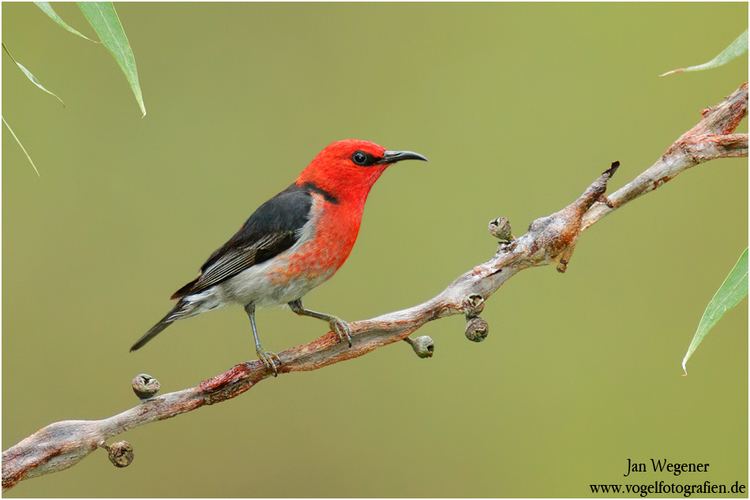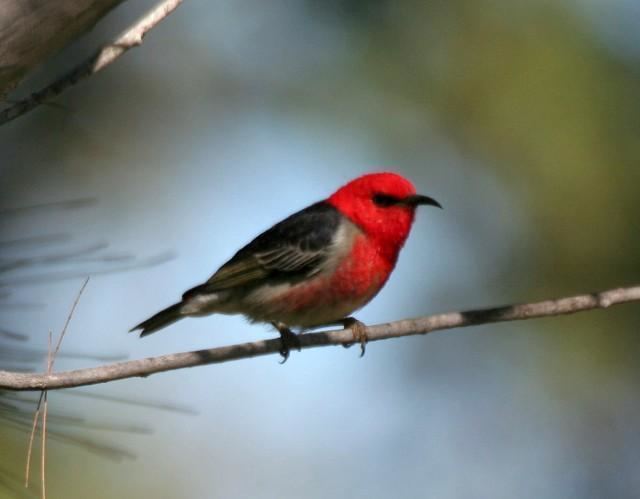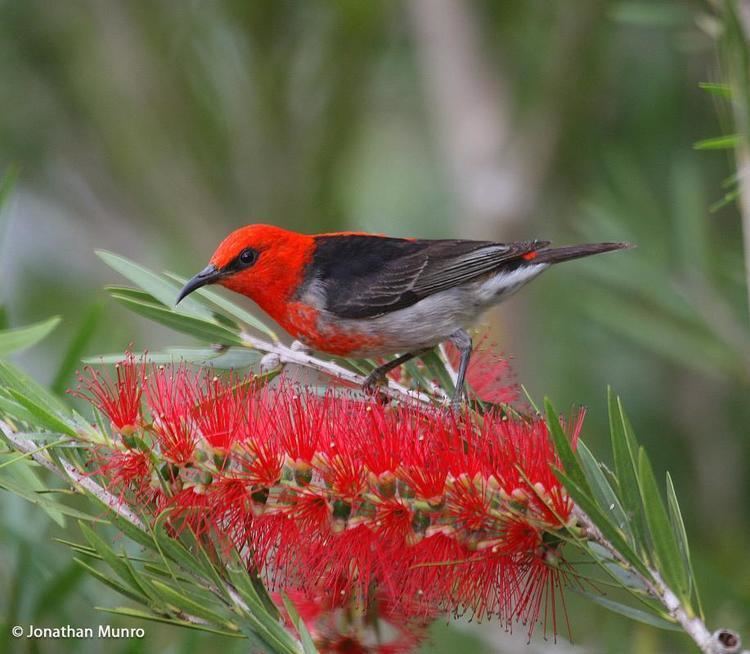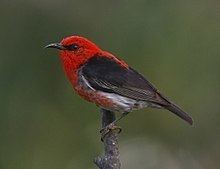Order Passeriformes Higher classification Myzomela | Phylum Chordata Family Meliphagidae Scientific name Myzomela sanguinolenta Rank Species | |
 | ||
Similar Honeyeater, Bird, Myzomela, Lewin's honeyeater, Yellow‑faced honeyeater | ||
Scarlet myzomela myzomela sanguinolenta hd video clip 1
The scarlet myzomela or scarlet honeyeater (Myzomela sanguinolenta) is a small passerine bird of the honeyeater family Meliphagidae native to the east coast of Australia, from Cape York in the far north to Gippsland in Victoria.
Contents
- Scarlet myzomela myzomela sanguinolenta hd video clip 1
- Taxonomy
- Description
- Distribution and habitat
- Feeding
- Breeding
- Aviculture
- References

At 9 to 11 cm long, it is the smallest honeyeater in Australia. It is sexually dimorphic; the male is a striking bright red with black wings, while the female is entirely brown. Its natural habitat is forest. It is omnivorous, feeding on insects as well as nectar.

Taxonomy

The scarlet myzomela was originally described as Certhia sanguinolenta by the English ornithologist John Latham in 1801, who gave it the common name of sanguineous creeper. In the same publication he described Certhia dibapha, the cochineal creeper, and C. erythropygia, the red-rumped creeper. These were all later determined to be the one species, with the first-written binomial name resolved as the valid one.

A 2004 genetic study of nuclear and mitochondrial DNA of honeyeaters found it to be most closely related to the cardinal myzomela, with their common ancestor diverging from a lineage that led to the red-headed myzomela, although only five of the thirty members of the genus Myzomela were analysed. A 2017 genetic study using both mitochondrial and nuclear DNA suggests that the ancestor of the scarlet myzomela diverged from that of the Banda myzomela around 2 million years ago, however the relationships of many species within the genus is uncertain. Molecular analysis has shown honeyeaters to be related to the Pardalotidae (pardalotes), Acanthizidae (Australian warblers, scrubwrens, thornbills, etc.), and the Maluridae (Australian fairy-wrens) in a large Meliphagoidea superfamily.

This species was known as the scarlet honeyeater in Australia, and scarlet myzomela elsewhere, the latter name being adopted as the official name by the IOC. Other common names are soldier-bird (wearing a red coat), and blood-bird. An early colonial name was little soldier.
Description
The scarlet myzomela is a distinctive small honeyeater with a compact body, short tail and relatively long down-curved black bill and dark brown iris. It is between 9 and 11 centimetres (3.5 and 4.3 in) long, with an average wingspan of 18 centimetres (7.1 in) and a weight of 8 grams (0.28 oz). The birds exhibit sexual dimorphism, with males much more brightly coloured than the females.
The adult male has a bright scarlet head and upper breast, with a narrow black stripe from beak to eye and a thin black eye-ring. The red plumage extends as a central stripe down the back and rump. On its breast, the red becomes more mottled with grey towards the belly and flanks, which are grey-white. The mantle and scapulars are black, the upperwing a dull black, with white edges to the secondary covert feathers. The tail is black above and dark grey below. The underwing is white with a dark grey trailing edge and tip.
The female has a brown head and neck, darker on top and lighter and greyer on the sides, with a pale grey-brown throat and chin. It sometimes has pinkish or reddish patches on the forehead, throat and cheeks. The upperparts are brown, sometimes with scarlet patches on the uppertail coverts. The tail is blackish-brown with yellow fringes to all bit the central pair of retrices. The wings are blackish-brown. A variety of calls have been recorded, including a bell-like tinkling.
Males could be mistaken for the similar looking red-headed myzomela in eastern Cape York Peninsula in north Queensland where their ranges overlap, though the latter's red colouration is restricted to the head and is sharply demarcated. The latter species also lives in mangroves rather than woodlands. The dusky myzomela resembles the female scarlet myzomela, but is larger with a longer bill and tail, and has much darker brown plumage and lacks the pink tinge to the face and throat.
Distribution and habitat
The scarlet myzomela is found from Cooktown in far north Queensland down the east coast to Mitchell River National Park in Gippsland, Victoria. It is rarer south of the Port Hacking River in New South Wales. Its range extends inland to Charters Towers, Carnarvon Gorge and Inglewood in Queensland, and the Warrumbungles in New South Wales. It is a rare vagrant to Melbourne.
It is found in dry sclerophyll forest and woodland, generally with eucalypts as the dominant trees.
Feeding
It is omnivorous, feeding on insects as well as nectar. Trees visited include turpentine (Syncarpia glomulifera), paperbarks (Melaleuca spp.) and banksias. Insects eaten include beetles, flies, bugs and caterpillars.
Breeding
Breeding season is from winter through to summer, with one or two broods a year. The nest consists of a tiny cup of shredded bark with spider web as binding, high up in tree canopy, or even mistletoe. The small eggs are white with the larger end flecked with dull red-brown or grey-purple.
Aviculture
Scarlet myzomelas are rarely seen in aviculture. Keeping them successfully requires a large commitment in time and experience. Various State regulations govern the keeping of the species, for instance, in South Australia a Specialist License is required, while in New South Wales a Class 2 licence is required. N.S.W. applicants must have at least 2 years experience keeping birds, and be able to demonstrate that they can provide the appropriate care and housing for the species they wish to obtain.
The late Mr. Neil Tuthill, of Murray Bridge, was awarded an R.W. McKechnie Memorial Medal by The Avicultural Society of South Australia Inc., for the first breeding of the scarlet honeyeater in South Australia.
